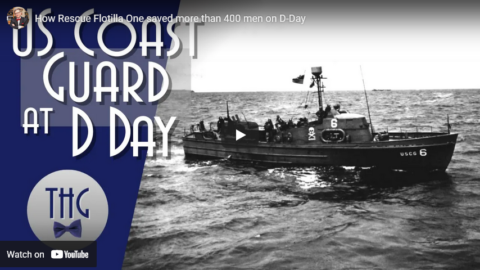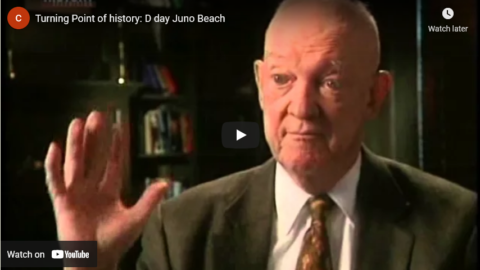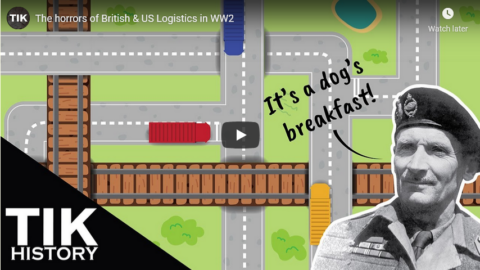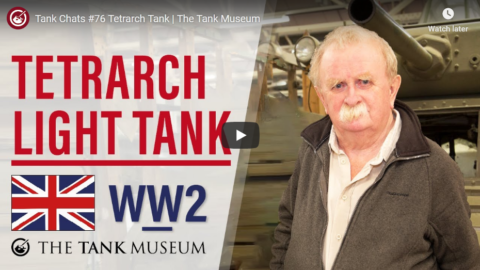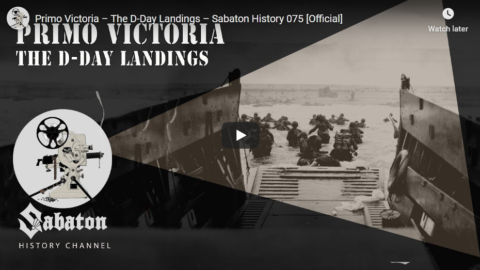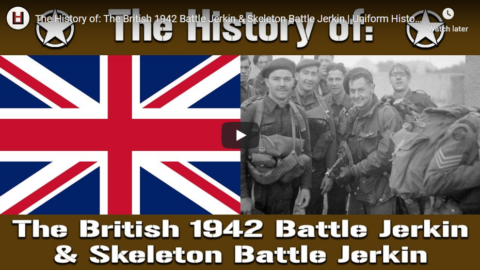World War Two
Published 14 Apr 2023We are getting closer and closer to D-Day and the potential liberation of Nazi Europe. But how much do the Germans know about this? Is the leak inside the British Embassy in Ankara enough to thwart the efforts of Operation Bodyguard, Operation Fortitude, and everything else the Allies are doing to deceive Adolf Hitler? Let’s find out. This is the story of Cicero.
(more…)
April 15, 2023
Do the Germans Know About Operation Overlord?
November 28, 2022
Mulberry Harbours – Rhinos, Whales, Beetles, Phoenixs and Spuds against the Axis
Drachinifel
Published 13 Jul 2022Today we take a look at the artificial harbours designed, built and then installed on the Normandy beaches in 1944.
Many thanks to @Think Defence for finding and collating so many images and letting me use them! Follow them on Twitter or on their website for more interesting articles!
(more…)
October 29, 2022
Your Thoughts on Our D-Day Coverage So Far – WW2 – Reading Comments
Updated with re-uploaded video, 3 Nov 2022. The original video was taken down within a few hours. This is the same video less one short rant that Indy reconsidered and has chosen to omit.
World War Two
Published 28 Oct 2022Indy and Sparty pick out some of the best, most interesting, and even controversial comments by you under our videos. Stay for the PJs.
(more…)
September 26, 2022
Did D-Day win WW2? – a WW2 expert discussion
World War Two
Published 25 Sep 2022WW2 historians Indy Neidell, Spartacus Olsson, and Paul Woodadge moderated by Ryan Socash discuss the meaning and significance of D-Day from historical, current, and future perspectives. Recorded on the road while shooting in Normandy for TimeGhost’s 24-hour documentary on the events of June 6, 1944.
(more…)
August 19, 2022
How Accurate is Saving Private Ryan? – WW2 D-Day Special
World War Two
Published 16 Aug 2022How accurate is that famous beach scene in Saving Private Ryan? Is it true to the history or just another Hollywood story? Seeing as we’re about to start the filming for our massive D-Day project, we figured we’d break it down, shot by shot.
(more…)
June 7, 2022
D Day: The First Canadian Parachute Battalion and the Battle for the Village of Varaville
The History Guy: History Deserves to Be Remembered
Published 6 Jun 2022There are so many stories of heroism involved in the massive Operation Overlord, among them the extraordinary story of the little-known first Canadian Parachute Battalion. The lightly armed Canadians were among the first allied soldiers to hit the ground in France on D-Day.
Check out our new community for fans and supporters! https://thehistoryguyguild.locals.com/
This is original content based on research by The History Guy. Images in the Public Domain are carefully selected and provide illustration. As very few images of the actual event are available in the Public Domain, images of similar objects and events are used for illustration.
You can purchase the bow tie worn in this episode at The Tie Bar:
https://www.thetiebar.com/?utm_campai…All events are portrayed in historical context and for educational purposes. No images or content are primarily intended to shock and disgust. Those who do not learn from history are doomed to repeat it. Non censuram.
Find The History Guy at:
New community!: https://thehistoryguyguild.locals.com/
Please send suggestions for future episodes: Suggestions@TheHistoryGuy.netThe History Guy: History Deserves to Be Remembered is the place to find short snippets of forgotten history from five to fifteen minutes long. If you like history too, this is the channel for you.
Awesome The History Guy merchandise is available at:
teespring.com/stores/the-history-guyScript by THG
#history #thehistoryguy #DDay
June 6, 2022
How Rescue Flotilla One saved more than 400 men on D-Day
The History Guy: History Deserves to Be Remembered
Published 2 Jun 2018The History Guy remembers the heroic service of Rescue Flotilla 1 of the United States Coast Guard during D-Day. It is history that deserves to be remembered.
The History Guy uses images that are in the Public Domain. As photos of actual events are sometimes not available, I will often use photographs of similar events and objects for illustration.
Patreon: https://www.patreon.com/TheHistoryGuy
The History Guy: Five Minutes of History is the place to find short snippets of forgotten history from five to fifteen minutes long. If you like history too, this is the channel for you.
Awesome The History Guy merchandise is available at:
teespring.com/stores/the-history-guyThe episode is intended for educational purposes. All events are presented in historical context.
#ushistory #militaryhistory #thehistoryguy
QotD: Eisenhower’s D-Day speech to the troops
[The near-perfect formulaic general’s speech before battle] has a few basic parts: I) an opening that focuses on the valor of the men rather than the impact of the speech (the common trope here is to note how “brave men require few words”) II) a description of the dangers arrayed against them, III) the profits to be gained by victory and the dire consequences of defeat IV) the basis on which the general pins his hope of success and finally V) a moving peroration; the big emotional conclusion of the speech. You can read through Catiline’s speech yourself; it’s not long and it follows the formula precisely. That order of elements is not rigid; they can be moved around and emphasis shifted. But I don’t just want to show that this trope existed in the ancient past, I want to show that it is projected through military tradition to the present. So let’s look at another very standard and somewhat more recent example, appropriate for June:
Soldiers, Sailors and Airmen of the Allied Expeditionary Force!
You are about to embark upon the Great Crusade, toward which we have striven these many months. The eyes of the world are upon you. The hopes and prayers of liberty-loving people everywhere march with you. In company with our brave Allies and brothers-in-arms on other Fronts, you will bring about the destruction of the German war machine, the elimination of Nazi tyranny over the oppressed peoples of Europe, and security for ourselves in a free world.
Your task will not be an easy one. Your enemy is well trained, well equipped and battle-hardened. He will fight savagely.
But this is the year 1944! Much has happened since the Nazi triumphs of 1940-1. The United Nations have inflicted upon the Germans great defeats, in open battle, man to man. Our air offensive has seriously reduced their strength in the air and their capacity to wage war on the ground. Our Home Fronts have given us an overwhelming superiority in weapons and munitions of war, and placed at our disposal great reserves of trained fighting men. The tide has turned! The free men of the world are marching together to Victory!
I have full confidence in your courage, devotion to duty and skill in battle. We will accept nothing less than full Victory!
Good Luck! And let us all beseech the blessing of Almighty God upon this great and noble undertaking.
Dwight D. Eisenhower, June 6th, 1944
I’ve highlighted an image of the signed document itself to show the various components of the ancient battle speech (following my numbering above): [https://acoupdotblog.files.wordpress.com/2020/06/breaking-down-the-speech.png?w=689]
Apart from a slight alteration of the order, it is not hard to assign this speech to the same genre as Sallust’s Catiline speech or even Thucydides’ speeches at Delium (Thuc. 4.92-95). As we’ll see, it is certainly not the case that there is no other way to structure a pre-battle exhortation (although, I should note that the standard text of the other famous pre-D-Day General’s speech, Patton’s speech to the Third Army, hits the same notes, but with more words – mostly profanity). But this is the standard structure of a battle speech in the Western literary canon, and speeches with this standard structure, or variations of it, appear frequently.
I think a reader might particularly be caught by the emphasis on a section stressing how formidable the enemy is and how great the danger is (“He will fight savagely”). That seems an odd thing to stress! But it is an important part of the structure of these speeches; it is almost never left out. When paired with the general’s own cause for hope, acknowledging the fearsome nature of the enemy and the general terror of battle is a way to inoculate the soldiers against the seizing fear of battle. The Greeks saw the fear of battle as two distinct elements, deimos (δεῖμος) – the creeping dread before a battle, and phobos (φόβος) – the sudden paralyzing panic in combat, the sharp fear that causes men to flee. If the encouragement of the speech (and the general’s presence) is meant to defuse deimos, openly discussing the fearfulness of the enemy (but couching it in terms of how it may be overcome) is meant to rob phobos of his sting. You do your soldiers no favors by concealing from them the terror they will experience regardless.
Now the bulk of Eisenhower’s D-Day order is dedicated to the fourth part, stating the ground for encouragement, generally framed by the reasons the general is confident despite how fearsome the enemy is. One form of encouragement is a recounting of the noble deeds of the soldiers themselves. One of the marks of good generalship for the Romans was if a general could go up and down the line, calling out individual soldiers and reminding them of great deeds they had performed (Caesar does this, for instance; note Catiline’s opponent, Marcus Petreius encourages his soldiers this way, calling out each one – his is an army of veterans – by name, 59.4). Alternately – especially for a fairly green army where no one has done any great deeds yet – the general might stress the great valor of their forefathers, or the honor of their city or state. The emotion being touched here is pretty clearly pride, tapping into a desire not to let one’s self, one’s community or one’s comrades down. That’s an effective rhetorical tactic; as we’ve discussed, the fear of shame is an effective combat motivator (where so many other motivations fail). Appealing to pride is a good way to arouse that fear of shame, as the two emotions are deeply connected. Alternately, a general may not a superiority in numbers, materiel, tactical position; he may discuss his battle-plan and how it is likely to bring victory. For forces defending on their own ground, the home-field advantage may be stressed.
You want to understand the “fearsome enemy” motif and the “grounds for encouragement” motif working best as a pair.
Consider it this way: you are about to take a very important test. If I, having already taken the test, tell you “oh, don’t worry, the test is easy,” that will help dispel your dread (deimos) before it, but when you sit down with the test paper and read the (quite difficult) questions, the seizing fear (phobos) hits you, and your overall performance is reduced. That seizing panic clouds your thoughts and costs you vital time; in a battle, it might cause you to flee or get you killed. But if I tell you “the test is hard, but (you’ve studied effectively/you can pick up points on XYZ section/etc.)” it not only diminishes the dread before the test, but serves to mentally prepare you for the shock of seeing the real thing. Indeed, I turn your fearful mind into my friend – when the real thing fails to live up to your worst nightmares, you’ll draw confidence from that. When the test turns out to be exactly like I said, the encouragement carries more weight because of the reliability of the warning. I am not dispelling your fear – because this is battle and everyone is afraid and no words can take that away – I am mentally preparing you for your fear. There’s an element of CBT in this: validate the emotion, suggest more helpful ways to think about it, and direct the mind towards behavioral solutions.
Finally, I think it is worth noting what is not generally here. While the speaker is likely to reflect on glorious deeds of the soldiers, or other soldiers like them, or their ancestors, there is generally not a focus on how fearsome or scary or strong they are because no one feels scary or strong when they are terrified. “You’ve done this before” is a good line (so is “our people have always beaten their people”) but “Remember, we are lions” is not. No one feels like a lion when they are receiving indirect fire and cannot fire back; no one feels like a lion when their buddy just went down next to them and there’s nothing they can do about it. Remember: the purpose of the speech isn’t to pump someone up before the charge, it is to emotionally prepare them for the moment when the emotional momentum of the charge is spent and the fear of death comes crashing in to replace it.
Likewise, while “the cause” often figures into such speeches, it does so as a subordinate element; some kind of group membership – the nation, the polis, the legion, comrades-in-arms – is often more prominent (note how Eisenhower’s speech crafts concentric circles of groups that the listener belongs to, watching and depending on the listener; “liberty-loving people everywhere” -> “the United Nations” and “our Allies” -> “our homefront” -> finally “us” and “we”). While it took until the late 1940s for group-cohesion-theory to really emerge on its own, these sorts of speeches show an awareness of what seems to be a timeless truth: the cause may get you to the battle, but only comrades will hold you in it when the dying starts (on this, note especially J. McPherson, For Cause and Comrades (1997)).
Bret Devereaux, “Collections: The Battle of Helm’s Deep, Part VII: Hanging by a Thread”, A Collection of Unmitigated Pedantry, 2020-06-12.
May 28, 2022
QotD: Breaking the trench stalemate with tactical air power
The first function aircraft were put to in WWI was reconnaissance. In 1914, that might mean locating the enemy in a fast-moving battlefield, but as soon as the trench stalemate set in, reconnaissance mostly meant identifying enemy buildups along the line and – still more importantly – serving as spotters for artillery. It wasn’t a huge cognitive leap to go from having aircraft which identified targets for the artillery to thinking that the aircraft could be the artillery. But as with tanks, the technical limitations of the platforms in use meant that actually meaningful close air support was still two decades away when the war ended. The rapid development of aircraft in these early days means that there is a truly bewildering array of aircraft designs in use during the war, but the Farman F.50 is a good sample for what the most advanced bombers in common use looked like towards the war’s end. It carried a maximum of eight 44kg (totalling 352kg) bombs under the wings, which were dropped unguided. With a maximum speed of less than 100mph and a service ceiling under 5000m, it was also an extremely vulnerable platform: fragile, slow and with a relatively low flight ceiling. The French mainly used bombers at night for this reason.
But how much airpower does it take to really move a division out of position? In 1944, at the start of Operation Cobra as part of the Normandy breakout, it was necessary for US forces to move the powerful armored division Panzer Lehr out of its prepared positions outside of St. Lo. Over the course of an hour and a half, the U.S. Eighth Air Force hit Panzer Lehr with approximately three thousand aircraft, including 1,800 heavy bombers (each of which might have had bomb-loads of c. 2-3,500kg; the attack would have been the equivalent of about 13,000 Farman F.50s (of which only a hundred or so were built!)). By this point, even medium bombers carried bomb loads in the thousands of pounds, like the B-25 Mitchell medium bomber, with a bomb load of 3000lbs (1360kg). This was followed by a hurricane artillery barrage! Despite this almost absurdly awesome amount of firepower (which, to be clear, inflicted tremendous damage; by the end of Operation Cobra, Panzer Lehr – the heaviest and most powerful Panzer division in the west – had effectively ceased to exist), Panzer Lehr, badly weakened was still very capable of resisting and had to be pushed out of position by ground attack over the next three days.
Needless to say, nothing on offer in 1918 or for a decade or more after, was prepared to offer that kind of offensive potential from the air. That kind of assault would have required many thousands of aircraft with capabilities far exceeding what even the best late-war WWI bombers could do. Once again, while close air support doctrine was developed with one eye on the trench stalemate and the role airpower could play in facilitating a breakthrough and restoring maneuver (either by blasting the breakthrough or – as in Soviet Deep Battle doctrine – engaging enemy rear echelon units to bog down reinforcements). But the technology wasn’t anywhere near the decisive point by 1918. Instead, the most important thing aircraft could do was spot for the artillery, which is mostly what aircraft continued to do, even in late 1918.
Bret Devereaux, “Collections: No Man’s Land, Part II: Breaking the Stalemate”, A Collection of Unmitigated Pedantry, 2021-09-24.
February 21, 2022
D-Day – The Biggest Trick in History – WW2 Special
World War Two
Published 17 Feb 2022It’s 1943, the preparations for D-Day have already begun: deceive the Wehrmacht. Here at TimeGhost, we have begun to prepare our D-Day for 2023, and we want you to join us! Find out how in the pinned comment.
(more…)
June 6, 2021
Turning Point of History: D-Day Juno Beach
ch1201
Published 8 Nov 2014Examines Canada’s role on June 6th, 1944 and the advance through Normandy, France.
March 16, 2021
The horrors of British & US Logistics in WW2
TIK
Published 15 Mar 2021The Allies may have had a lot of resources, manpower and industry, but that didn’t mean that their logistics weren’t inefficient or a disorganized mess. Today, we’re going to look at how the British railways were disaster during WW2, how the Americans ran out of fuel on the way to Germany, and why Montgomery called the planning for the invasion of Sicily a “dog’s breakfast”.
⏲️ Videos EVERY Monday at 5pm GMT (depending on season, check for British Summer Time).
The thumbnail for this video was created by Terri Young. Need graphics? Check out her website here https://www.terriyoungdesigns.co.uk/
– – – – –
📚 BIBLIOGRAPHY / SOURCES 📚
Dunn, W. The Soviet Economy and the Red Army, 1930-1945. Praeger Publishers, 1995.
Garvey, J. Operation Husky: The Untold Story of the logistics of the Sicily Invasion. Farm Publications, Kindle 2019.
Hazlitt, H. Economics in One Lesson: The Shortest & Surest Way to Understand Basic Economics. Three Rivers Press, 1979.
MacDonald, J. Supplying the British Army in the Second World War. Pen & Sword Military, Kindle 2020.
Molony, C. The Mediterranean and Middle East, Volume V, The Campaign in Sicily 1943 and The Campaign in Italy 3rd September 1943 to 31st March 1944. The Naval & Military Press LTD 2004, first published in 1973.
Wolmar, C. Fire & Steam: How the Railways Transformed Britain. Atlantic Books, Kindle 2007.British Government, Railways Act 1921, https://www.legislation.gov.uk/ukpga/…
Full list of all my sources https://docs.google.com/spreadsheets/…
– – – – –
⭐ SUPPORT TIK ⭐
This video isn’t sponsored. My income comes purely from my Patreons and SubscribeStars, and from YouTube ad revenue. So, if you’d like to support this channel and make these videos possible, please consider becoming a Patreon or SubscribeStar. All supporters who pledge $1 or more will have their names listed in the videos. For $5 or more you can ask questions which I will answer in future Q&A videos (note: I’m behind with the Q&A’s right now, and have a lot of research to do to catch up, so there will be a delay in answering questions). There are higher tiers too with additional perks, so check out the links below for more details.
https://www.patreon.com/TIKhistory
https://www.subscribestar.com/tikhistoryThank you to my current supporters! You’re AWESOME!
– – – – –
ABOUT TIK 📝
History isn’t as boring as some people think, and my goal is to get people talking about it. I also want to dispel the myths and distortions that ruin our perception of the past by asking a simple question – “But is this really the case?”. I have a 2:1 Degree in History and a passion for early 20th Century conflicts (mainly WW2). I’m therefore approaching this like I would an academic essay. Lots of sources, quotes, references and so on. Only the truth will do.
This video is discussing events or concepts that are academic, educational and historical in nature. This video is for informational purposes and was created so we may better understand the past and learn from the mistakes others have made.
July 28, 2020
Tank Chats #76 Tetrarch Tank | The Tank Museum
The Tank Museum
Published 31 May 2019Tetrarch tanks were flown over on D-Day, 6th June, 1944, for the invasion of France during WW2. Find out more with David Fletcher.
Originally adopted by the British Army as a light tank it became the first British airborne tank.
Many thanks to Vitaly Kuzmin for providing the image of the Tetrarch at Kubinka https://www.vitalykuzmin.netSupport the work of The Tank Museum on Patreon: ► https://www.patreon.com/tankmuseum
Visit The Tank Museum SHOP: ► https://tankmuseumshop.org/
Twitter: ► https://twitter.com/TankMuseum
Tiger Tank Blog: ► http://blog.tiger-tank.com/
Tank 100 First World War Centenary Blog: ► http://tank100.com/ #tankmuseum #tanks #DDay75 #tankchats
July 10, 2020
“Primo Victoria” – The D-Day Landings – Sabaton History 075 [Official]
Sabaton History
Published 9 Jul 2020On D-Day, 6th June 1944, Operation Overlord began. The Western Allies unleashed their gigantic amphibious landing on the coast of Normandy. Preluded by a nightly airborne attack and supported by a massive armada of bombers and fleet artillery, their landing-craft reached the fortified beaches. Against a hail of machine-gun bullets, the Allied soldiers stormed the beaches and overran the German bunkers and trenches. A new front was opened and the battle for France began.
Support Sabaton History on Patreon: https://www.patreon.com/sabatonhistory
Listen to “Primo Victoria” on the album Primo Victoria:
CD: http://bit.ly/PrimoVictoriaStore
Spotify: http://bit.ly/PrimoVictoriaSpotify
Apple Music: http://bit.ly/PrimoVictoriaAppleMusic
iTunes: http://bit.ly/PrimoVictoriaiTunes
Amazon: http://bit.ly/PrimoVictoriaAmzn
Google Play: http://bit.ly/PrimoVictoriaGooglePlayWatch the Official Lyric Video of “Primo Victoria” here: https://www.youtube.com/watch?v=qVHyl…
Listen to Sabaton on Spotify: http://smarturl.it/SabatonSpotify
Official Sabaton Merchandise Shop: http://bit.ly/SabatonOfficialShopHosted by: Indy Neidell
Written by: Markus Linke and Indy Neidell
Directed by: Astrid Deinhard and Wieke Kapteijns
Produced by: Pär Sundström, Astrid Deinhard and Spartacus Olsson
Creative Producer: Joram Appel
Community Manager: Maria Kyhle
Executive Producers: Pär Sundström, Joakim Broden, Tomas Sunmo, Indy Neidell, Astrid Deinhard, and Spartacus Olsson
Post-Production Director: Wieke Kapteijns
Edited by: Karolina Dołęga
Sound Editing by: Marek Kaminski
Maps by: Eastory – https://www.youtube.com/c/eastory
Archive by: Reuters/Screenocean – https://www.screenocean.com
Colorizations by: Julius Jääskeläinen – https://www.facebook.com/JJcolorization/
Music by: SabatonSources:
National Archives NARA
Bundesarchiv
US Holocaust Memorial Museum
Imperial War Museums: IWM H 39183, H38244 IWM, 1944_B5234, 944_TR1631, IWM A70 31-1, IWM A70 31-2,EA25734, B 5218, 1944_MH9509, IWM A70 29-1-2, B5225, B5089
Icons from The Noun Project by zidney and Norbert de GraaffAn OnLion Entertainment GmbH and Raging Beaver Publishing AB co-Production.
© Raging Beaver Publishing AB, 2019 – all rights reserved.
July 3, 2020
The History of: The British 1942 Battle Jerkin & Skeleton Battle Jerkin | Uniform History
Uniform History
Published 24 Mar 2020The start of another two parter, in this one we cover the British Battle Jerkin family as it helped inspire the US Normandy Assault Vest’s creation.
Music by: https://www.juliancrowhurst.com/


